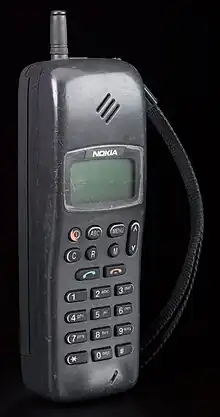 | |
| Manufacturer | Nokia |
|---|---|
| Model | NHE-2XN |
| Compatible networks | GSM 900 |
| Availability by region | 10 November 1992 |
| Successor | Nokia 2010 Nokia 2110 |
| Related | Nokia 1610 Mobira Cityman 2000 |
| Form factor | Brick |
| Dimensions | 195 x 60 x 45mm (with standard battery and internal antenna) |
| Mass | 495g |
| Operating system | embedded |
| Memory | 99-entry Phonebook |
| Battery | Ni-CD 7.2V 900 mAh |
| Display | 2-line, 8-character monochrome LCD with dedicated function symbols |
| Data inputs | Numeric keypad |
| Development status | Discontinued, extremely rare |
The Nokia 1011 (NHE-2X5, NHE-2XN) is the first mass-produced GSM phone. It was sold also as Mobira Cityman 2000. The typenumber refers to the launch date, 10 November 1992.[1]
The black handset measured 195 x 60 x 45 mm and featured a monochrome LCD and an extendable antenna. The memory could hold 99 phone numbers. It did not yet employ Nokia's characteristic ringtone: that was only introduced in 1994. The phone operated in the 900 MHz GSM band. At that time the device cost about 2500 DM[2] (about 2120 euros today).
The phone was able to send and receive SMS messages, even if Nokia says that its model 2110 phone was the first SMS-enabled GSM phone.
Nokia 1011 continued production until 1994, when Nokia 2010 and Nokia 2110 were introduced as successors.
References
- ↑ "15 years ago: the first mass-produced GSM phone". The Register. Archived from the original on 7 August 2012. Retrieved 10 November 2007.
- ↑ "Mobilfunk-Geschichte: Mit dem Telefonkoffer durchs Land" [Mobile History: With phone suitcase throughout the country] (in German). Focus.de. 26 March 2009. Retrieved 10 February 2014.